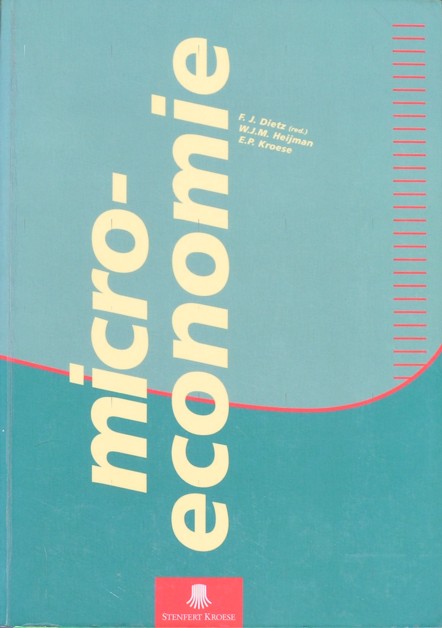

My shared history with the book Micro-economie van Dietz, Heijman and Kroese dates from far back, shortly seventeen years. I was unemployed then, and wanted to do something as a consultant in the natural sciences. My dismissal had taught me to widen my perspectieve, and a bit of self-study in economics seemed a good start. In the same period I spent many hours in the chain stores of what then was still Selexyz1, and out of all those meters of books I selected Micro-economie. In this manner it became my first book in economics. It turned out to be an excellent choice. Life is full of surprises.
Political economics did not yet fascinate me, and Het kapitaal by Marx merely had a place in my bookcase, because I had to make a monthly buy as a member of the bookclub ECI, and because it coloured nicely next to Don Quichote and the Father Brown omnibus book. This indeed is an indication of my then taste. Micro-economie completely satisfied my simple requirements: an extensive explanation about consumption and enterprise (668 pages!), and many mathematical formulas. Besides the book is in Dutch. Although since then my interests have shifted, Micro-economie never left my has side. The book is simply so versatile. All is there. So this review could have been the first one on the portal, were it not for a significant shortcoming of the book: any originality is lacking.
The subjects are explained clearly, step by step, as is proper for an introductory text. Autodidacts will appreciate this property. A special quality of Micro-economie is the focus on the Dutch situation. For instance, the influence of the Dutch institutions on the wage bargaining is described in detail. The legal forms of enterprises in the Netherlands are also explained, as well as the lease system. Another advantage is, that special attention is paid to the work of Dutch economists. The book was the first to introduce your reviewer to P. Hennipman and B.M.S. van Praag. When the theory is illustrated with applications, they are often taken from the Dutch practice (the construction of a second airport, etcetera).
After this exulting introduction some nuances must be made. The book truly limits itself to micro-economics, in the presently common form. Macro-economics is treated merely in the form of the general Walrasian equilibrium and the Paretian welfare criterion. In short, the authors only use the neoclassical paradigm (also called the marginalist or subjective paradigm). Those who prefer a complete summary of all paradigm must look elsewhere, for instance in Volkswirtschaftslehre by Heine and Herr2. But Micro-economie does give a profound presentation of the neoclassical paradigm. The book truly tries to be complete.
Micro-economie discusses themes, that are missing in all other textbooks about micro-economics. Some examples: the hierarchy of needs according to Maslow (truly important!), the Method struggle, dynamical models (especially the so-called pigs-cycle), the inter-temporal utility function, price politics, and competition by means of advertising. It is pardonable, that merely a bird's-eye view of the classical paradigm is presented. In the paragraphs with political and constitutional considerations a neutral position is maintained. The authors avoid the various social conflicts - which incidentally is also a political choice3. The reader should consult other books for political analyses, which however require Micro-economie as an indispensable introduction.
However, it is a serious fault, that the neoricardian theory of Sraffa has been omitted. The authors excuse themselves: "At this place it would go too far to discuss the contents of the Cambridge-Cambridge debate, the more since it is characterized by difficult technical arguments". That does not convince in such an extensive volume. Thus Micro-economie leaves the unsuspecting reader with wrong ideas, such as that the substitution of the production factors labour and capital would react in a "logical" manner to changes in the factor prices. In this respect the authors have become entangled in the Anglosaxon dogmatism, and the book is quietly yet quite ideological. The reader should consult French or German books for a more modern explanation, such as the already mentioned book Volkswirtschaftslehre4.
This serious omission illustrates in a profound manner, that more than one source must always be consulted in order to acquire the right insights. Usually various approaches of the theory are possible, and author(s) are forced to make a choice. Moreover, no books is complete. For instance, Micro-economie does explain the Edgeworth box, but other books do this better. And Micro-economie merely presents a superficial discussion of external effects, in general terms, without the accompanying mathematics. The book is truly not more than an introduction. Profound discussions about macro-economic themes such as the conjuncture- and growth-theory are evidently absent. The authors remain stuck in the Paretian dreamworld5.
The book prefers the common structure of the neoclassical paradigm. The 35 chapters are ordered in six encompassing parts. In the first part about the subject and the method the most important economic concepts are defined and explained. The second part treats the consumer behaviour, and the third part studies the behaviour of producers. The fourth part concerns the formation of prices for the end products, and includes a discussion of the various market forms. The fifth part treats the price formation of the production factors. Finally, in the sixth part the preceding texts are combined by means of the analysis of the general Walrasian equilibrium, and by means of the welfare theory. Here the book addresses macro-economic subjects, without, as has just been remarked, abandoning the neoclassical paradigm.